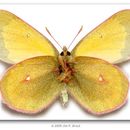Conservation Status
fornecido por University of Alberta Museums
Not of concern.
- licença
- cc-by-nc
- direitos autorais
- University of Alberta Museums
Cyclicity
fornecido por University of Alberta Museums
One yearly brood peaking from late May to late July, depending on habitat.
- licença
- cc-by-nc
- direitos autorais
- University of Alberta Museums
Distribution
fornecido por University of Alberta Museums
Eastern Alaska to northern BC and Alberta (Opler 1999), south in the Alberta foothills to Highwood Pass (Layberry et al. 1998).
- licença
- cc-by-nc
- direitos autorais
- University of Alberta Museums
General Description
fornecido por University of Alberta Museums
The only other Alberta Colias with a dorsal orange colour that extends all the way to the forewing base are meadii and eurytheme. The Canada Sulphur, however, has the pink outline of the underside discal spot smeared outwards, and almost always lacks the hindwing underside submarginal dark spots. This species was only recently found to be distinct from C. hecla by Cliff Ferris (1988).
- licença
- cc-by-nc
- direitos autorais
- University of Alberta Museums
Habitat
fornecido por University of Alberta Museums
Moist, open areas including shrub willow-birch valley bottoms and alpine tundra.
- licença
- cc-by-nc
- direitos autorais
- University of Alberta Museums
Life Cycle
fornecido por University of Alberta Museums
The mature larva overwinters, and is dark green covered with short, fine hairs arising from small black spots (Guppy & Shepard 2001). The dorsal line is dark, and the lateral line is white and pinkish-red (Guppy & Shepard 2001).
- licença
- cc-by-nc
- direitos autorais
- University of Alberta Museums
Trophic Strategy
fornecido por University of Alberta Museums
The larval foodplants are unkown, but are likely to be legumes. Females lay eggs on Hedysarum (Fabaceae) in captivity, and larvae can be successfully reared on red clover (Guppy & Shepard 2001).
- licença
- cc-by-nc
- direitos autorais
- University of Alberta Museums

